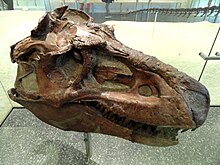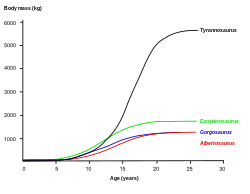Albertosaurinae
| Albertosaurines | |
|---|---|

| |
| Albertosaurus skull cast | |

| |
| Gorgosaurus skull | |
| Scientific classification | |
| Domain: | Eukaryota |
| Kingdom: | Animalia |
| Phylum: | Chordata |
| Clade: | Dinosauria |
| Clade: | Saurischia |
| Clade: | Theropoda |
| Superfamily: | †Tyrannosauroidea |
| Clade: | † Pantyrannosauria
|
| Clade: | †Eutyrannosauria |
| Family: | †Tyrannosauridae |
| Subfamily: | †Albertosaurinae Currie et al., 2003 |
| Type species | |
| † Osborn, 1905
| |
| Genera[1][2][3] | |
Albertosaurines, or dinosaurs of the subfamily Albertosaurinae, lived in the
Description
Albertosaurines are large, lightly built tyrannosaurids. Compared to tyrannosaurines, they are more slender and have shorter, flatter skulls, shorter ilia, and proportionally longer tibiae. Albertosaurines and tyrannosaurines share arms of about equal length, with the exception of Tarbosaurus, which had short arms for its size.[1]

Albertosaurus was smaller than some other tyrannosaurids, such as Tarbosaurus and Tyrannosaurus. Typical adults of Albertosaurus and Gorgosaurus measured up to 8 to 9 m (26 to 30 ft) long,[4][5] while rare individuals of Albertosaurus could grow to over 10 m (33 ft) in length.[6] Several independent mass estimates, obtained by different methods, suggest that an adult Albertosaurus weighed between 1.3 tonnes (1.4 short tons; 1.3 long tons) and 2 tonnes (2.2 short tons; 2.0 long tons).[7][8][9][10] Gorgosaurus estimates are higher, around 2.5 tonnes (2.8 short tons; 2.5 long tons),[11][10] although greater estimates exist of about 2.8–2.9 tonnes (3.1–3.2 short tons; 2.8–2.9 long tons).[12][9]
All tyrannosaurids, including Albertosaurus, shared a similar body appearance. Typical for a theropod, Albertosaurus was bipedal and balanced its heavy head and
Classification and systematics
The subfamily was first used by
Albertosaurus is a member of the theropod
Relationship of Gorgosaurus and Albertosaurus
The close similarities between Gorgosaurus libratus and Albertosaurus sarcophagus have led many experts to combine them into one genus over the years. Albertosaurus was named first, so by convention it is given
Phylogeny
Albertosaurinae is a
| Tyrannosauridae |
| ||||||||||||||||||
Paleobiology
Coexistence of Gorgosaurus and Daspletosaurus
In the middle stages of the Dinosaur Park Formation, Gorgosaurus lived alongside a rarer species of tyrannosaurine, Daspletosaurus. This is one of the few examples of two tyrannosaurid genera coexisting. Similar-sized predators in modern predator
Unlike some other groups of dinosaurs, neither genus was more common at higher or lower elevations than the other.[23] However, Gorgosaurus appears more common in northern formations like Dinosaur Park, with species of Daspletosaurus more abundant to the south. The same pattern is seen in other groups of dinosaurs. Chasmosaurine ceratopsians and hadrosaurine hadrosaurs are also more common in the Two Medicine Formation of Montana and in southwestern North America during the Campanian, while centrosaurine and lambeosaurines dominate in northern latitudes. Holtz has suggested this pattern indicates shared ecological preferences between tyrannosaurines, chasmosaurines, and hadrosaurines. At the end of the later Maastrichtian stage, tyrannosaurines like Tyrannosaurus rex, hadrosaurines like Edmontosaurus annectens, and chasmosaurines like Triceratops were widespread throughout western North America, while lambeosaurines were rare and the albertosaurines and centrosaurines had gone extinct.[5]
Growth

Gorgosaurus spent as much as half its life in the juvenile phase before ballooning up to near-maximum size in only a few years.[7] This, along with the complete lack of predators intermediate in size between huge adult tyrannosaurids and other small theropods, suggests these niches may have been filled by juvenile tyrannosaurids. This pattern is seen in modern Komodo dragons, whose hatchlings start off as tree-dwelling insectivores and slowly mature into massive apex predators capable of taking down large vertebrates.[5]
During growth, thickening of the tooth morphology changed so much that, had the association of young and adult skeletons on the Dry Island bonebed not proven they belonged to the same taxon, the teeth of juveniles would likely have been identified by statistical analysis as those of a different species.[25]
Life history
Most known Albertosaurus individuals were aged 14 years or more at the time of death.
A hypothesis of Albertosaurus life history postulates that hatchlings died in large numbers, but have not been preserved in the fossil record due to their small size and fragile construction. After just two years, juveniles were larger than any other predator in the region aside from adult Albertosaurus and more fleet of foot than most of their prey animals. This resulted in a dramatic decrease in their mortality rate and a corresponding rarity of fossil remains. Mortality rates doubled at age twelve, perhaps the result of the physiological demands of the rapid growth phase, and then doubled again with the onset of sexual maturity between the ages of fourteen and sixteen. This elevated mortality rate continued throughout adulthood, perhaps due to the high physiological demands of procreation, including stress and injuries received during intraspecific competition for mates and resources, and eventually, the ever-increasing effects of senescence. The higher mortality rate in adults may explain their more common preservation. Very large animals were rare because few individuals survived long enough to attain such sizes. High infant mortality rates, followed by reduced mortality among juveniles and a sudden increase in mortality after sexual maturity, with very few animals reaching maximum size, is a pattern observed in many modern large mammals, including elephants, African buffalo, and rhinoceros. The same pattern is also seen in other tyrannosaurids. The comparison with modern animals and other tyrannosaurids lends support to this life history hypothesis, but bias in the fossil record may still play a large role, especially since more than two-thirds of all Albertosaurus specimens are known from one locality.[6][27] Albertosaurus and Gorgosaurus individuals both grow the most rapidly during a four-year period until they are approximately 16.[6]
Pack behaviour
The Dry Island bonebed discovered by Barnum Brown and his crew contains the remains of 26 Albertosaurus, which is the most individuals found in one locality of any large Cretaceous theropod and the second-most of any large theropod dinosaur behind the
The near-absence of herbivore remains and the similar state of preservation common to the many individuals at the Albertosaurus bonebed quarry led Currie to conclude that the locality was not a predator trap like the La Brea Tar Pits in California and that all of the preserved animals died at the same time. Currie claims this as evidence of pack behaviour.[14] Other scientists are skeptical, observing that the animals may have been driven together by a drought, flood, or for other reasons.[6][26][29]
There is plentiful evidence for gregarious behaviour among herbivorous dinosaurs, including
See also
References
Footnotes
- ^ a b c d e f g Currie, Hurum & Sabath 2003.
- ^ a b c Loewen et al. 2013.
- ^ a b c d e Fiorillo & Tykoski 2014.
- ^ a b c Russell 1970.
- ^ a b c d e f Holtz 2004.
- ^ a b c d e f g Erickson et al. 2006.
- ^ a b c d Erickson et al. 2004.
- ^ Christiansen & Fariña 2004.
- ^ S2CID 84317234.
- ^ PMID 24802911.
- ^ Seebacher 2001.
- ^ Therrien & Henderson 2007.
- ^ Thulborn 1982.
- ^ a b Currie 2000.
- ^ Saveliev & Alifanov 2007.
- ^ Currie 2002.
- ^ a b c d Currie 2003.
- ^ Holtz 2005.
- ^ a b Carr, Williamson & Schwimmer 2005.
- ^ Matthew & Brown 1922.
- ^ Paul 1988.
- ^ Paul 2010.
- ^ a b Farlow & Pianka 2002.
- ^ Varricchio 2001.
- doi:10.1139/e10-029.
- ^ a b c d Roach & Brinkman 2007.
- ^ Erickson et al. 2010.
- ^ Tanke, Darren H. (2011). "A History of Albertosaurus-related Popular Culture Events and Activities in Canada". Alberta Palæontological Society Bulletin. 26 (2): 12–30.
- S2CID 220414868.(published abstract only)
- ISBN 978-0-12-226810-6.
- .
- ISBN 978-0-521-43810-0.
- ^ Coria, Rodolfo A.; & Currie, Philip J. (2006). "A new carcharodontosaurid (Dinosauria, Theropoda) from the Upper Cretaceous of Argentina" (PDF). Geodiversitas. 28 (1): 71–118. Archived from the original (PDF) on 26 March 2009. Retrieved 2009-05-03.
- ^ a b Currie et al. 2005.
- ^ Tanke & Currie 1998.
Bibliography
- Carr, Thomas D.; Williamson, Thomas E.; Schwimmer, David R. (2005). "A new genus and species of tyrannosauroid from the Late Cretaceous (middle Campanian) Demopolis Formation of Alabama". Journal of Vertebrate Paleontology. 25 (1): 119–143. S2CID 86243316.
- S2CID 84322349.
- Currie, P.J. (2000). "Possible evidence of gregarious behavior in tyrannosaurids" (PDF). Gaia. 15: 271–277. Archived from the original (PDF) on 2009-03-26.
- doi:10.1139/e02-083.
- Currie, P.J. (2003). "Cranial anatomy of tyrannosaurids from the Late Cretaceous of Alberta" (PDF). Acta Palaeontologica Polonica. 48 (2): 191–226.
- Hurum, J.H.; Sabath, K. (2003). Holtz, Thomas R. Jr.; Osmólska, Halszka (eds.). "Skull structure and evolution in tyrannosaurid dinosaurs" (PDF). Acta Palaeontologica Polonica. 48 (2): 227–234.
- ISBN 978-0-253-34539-4.
- S2CID 4404887. Archived from the original(PDF) on 2011-10-06. Retrieved 2014-04-16.
- S2CID 34191607. Archived from the original(PDF) on 2010-07-18.
- doi:10.1139/E10-051.
- S2CID 18114585.
- PMID 24621577.
- Holtz, T.R.Jr. (2005-09-20). "RE: Burpee Conference (LONG)". Dinosaur Mailing List. Retrieved 2007-06-18.
- ISBN 978-0-520-24209-8.
- PMID 24223179.
- Matthew, W.D.; Brown, B. (1922). "The family Deinodontidae, with notice of a new genus from the Late Cretaceous of Alberta" (PDF). Bulletin of the American Museum of Natural History. 46 (6): 367–385. Archived from the original (PDF) on 2014-04-16.
- ISBN 978-0-671-61946-6.
- ISBN 978-0-691-13720-9.
- S2CID 84175628.
- ASIN B0006C6VM8.
- S2CID 53529148.
- S2CID 53446536.
- Tanke, D.H.; Currie, P.J. (1998). "Head-biting behavior in theropod dinosaurs: paleopathological evidence" (PDF). Gaia. 15: 167–184. Archived from the original (PDF) on 2008-02-27.
- S2CID 86025320.
- .
- S2CID 86113170.
External links
- "Albertosaurinae". Fossilworks: Gateway to the Paleobiology Database.
